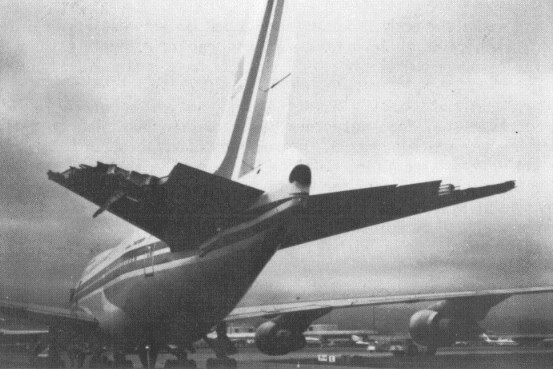On February 19, 1985, China Airlines Flight 006 departed from Taipei destined for Los Angeles, California. The Boeing 747-SP was laden with 251 passengers and 23 crew. On the flight deck were three experienced flight crew as well as a relief Captain and a relief flight engineer.
The flight was routine from Taipei up to around 300nm northwest of San Francisco, When the aircraft entered an area of clear air turbulence (CAT) while cruising at 41,000ft. Shortly afterwards, the No.4 (outboard right) engine lost power.
As the flight engineer began to diagnose the problem and attempt a restart procedure, and while the First Officer calculated a new three engine cruise altitude, the airspeed started to decrease and the aircraft, with asymmetric thrust, began to roll to the right.
As the aircraft’s speed decreased further, the Captain disengaged the autopilot and the aircraft sharply rolled further to the right. Within 1 minute the 747 had rolled through 90 degrees pitching down nearly 30 degrees. The aircraft, in free fall, rolled further through 180 degrees, with the nose pointing down to the ocean below.
The crew were in disbelief at their attitude directional indicators (ADIs), which display the aircraft orientation relative to the horizon, and determined that they must have failed. Confused and with no visual horizon owing to the whiteout of the cloud, the crew had no idea what corrective inputs to make to return to a stable, level flight.
Descending through 11,000ft, the aircraft broke through the bottom of the cloud and the crew, now having a horizon, oriented themselves and the Captain brought the plane under control, levelling off at 9,600ft.
Once levelled off and after a restart procedure by the flight engineer, the No.4 engine functioned as normal. The crew had elected to continue towards Los Angeles and informed ATC of their intentions when they realized the landing gear was down. Owing to the extra drag and increased fuel consumption, the crew decided to divert to San Francisco.
The plane landed without further issues and was towed to the gate to assess the damage.
The 747 aircraft had dived 30,000ft in under two and a half minutes, suffering excessive G-forces of up to 5.1G, meaning that passengers at times would have felt four times their body weight. The sheer forces and stress the plane underwent during the dive ripped off the landing gear doors, which led to the gear extension. The wings were bent upwards between two and three inches, and large chunks of the horizontal stabilizer had separated. Fortunately, there was only one serious injury.
What went wrong?
Engine Trouble
The investigation noted that just before the No.4 engine malfunction, the aircraft had encountered clear air turbulence (CAT). As the aircraft entered the CAT, the effect was a reduced airspeed and, consequently, the autopilot advanced the throttles. Engines 1, 2 and 3 all responded quickly, but the No.4 engine was slower in providing the thrust and began to ‘hang’ (a term used to describe an RPM slightly lower than idle). The engine had not flamed out as the flight crew had previously thought.
This hanging was caused due to the schematics of the aircraft, with the No.4 engine supplying bleed-air to the cabin. During the initial restart attempt, the flight engineer failed to close the bleed-air valve. However, it is thought that even with this action, the aircraft was at too high an altitude and with too little oxygen to successfully complete a restart procedure.
Flight Crew Response
The investigation turned to the actions of the crew and, in particular, those of the Captain.
The roll down of the right-hand wing was caused by asymmetric thrust, the engines on the left wing producing more thrust than the right. This leads to a yaw effect, which due to aerodynamics has a secondary effect of roll. In this case, both to the right.
The Captain neglected the aircraft entering a right bank and the autopilot (AP), which was still engaged, was masking the immense control inputs being used in an attempt to return to level flight. He did not disengage the AP at the onset of the engine malfunction, as both his training and the training manual stated he should have.
At high altitude, the aircraft systems only allow the use of the smaller, outer control surfaces of the wing, to prevent stress on the aircraft through excessive inputs. In the case of Flight 006, the AP had no more aileron deflection remaining to counter the roll and it does not control the rudder.
It came to light that at no point during the loss of thrust from the No.4 engine did the Captain use rudder or rudder trim, which crews are trained to use, in this case to the left, to counter the effects of the asymmetric thrust.
When the Captain disengaged the autopilot, three minutes and 40 seconds after the beginning of the upset, he was not prepared for the huge force needed to correct the bank, hence the sharp roll and dive that followed.
It was only once out of the cloud, with visual references to the horizon and the fast-approaching ocean below, that the crew were able to recover.
Outcomes
The National Transportation Safety Board (NTSB) concluded that the Captain caused the accident by becoming too focused on the engine malfunction, and his failure to effectively monitor the flight instruments and maintain control of the aircraft.
The Investigation believed the Captain might have been suffering from a mixture of fatigue, boredom and monotony. The report stated that if the Captain had engaged a more ‘hands on’ relationship with the aircraft from the beginning of the upset, he most likely would have stimulated his situational awareness and his responses and inputs would have been more coordinated to recover sooner.
*Aircraft upset: An undesired airplane state characterized by unintentional divergences from parameters normally experience during operations – International Civil Aviation Organization (ICAO).

